Research on Inlet and Outlet Structure Optimization to Improve the Performance of Piezoelectric Pump
Abstract
:1. Introduction
2. Structure and Working Principle of the Elastic Inlet and Outlet
3. Mechanism Analysis of Elastic Inlet and Outlet to Reduce Liquid Dynamic Load
4. Effect of the Elastic Cavity Height on the Performance of Piezoelectric Pump
4.1. Fluid Simulation
4.2. Theoretical Analysis
5. Prototype Fabrication and Experimental Device
5.1. Experimental Prototypes
5.2. Experimental Device
6. Results and Analysis
6.1. Performance Improvement of Piezoelectric Pump by Elastic Inlet and Outlet
6.2. Effect of the Elastic Cavity Height on the Performance of Piezoelectric Pump
7. Conclusions
Author Contributions
Funding
Acknowledgments
Conflicts of Interest
References
- Woias, P. Micropumps-past, progress and future prospects. Sens. Actuators B Chem. 2005, 105, 28–38. [Google Scholar] [CrossRef]
- Liu, C.; Zhu, Y.; Wu, C. Optimization of a synthetic jet based piezoelectric air pump and its application in electronic cooling. Microsyst. Technol. 2020, 1–10. [Google Scholar] [CrossRef]
- Bao, Q.; Zhang, J.; Tang, M.; Huang, Z.; Lai, L.; Huang, J.; Wu, C. A Novel PZT Pump with Built-in Compliant Structures. Sensors 2019, 19, 1301. [Google Scholar] [CrossRef] [PubMed] [Green Version]
- Ma, H.K.; Hou, B.R.; Lin, C.Y.; Gao, J.J. The improved performance of one-side actuating diaphragm micropump for a liquid cooling system. Int. Commun. Heat Mass Transf. 2008, 35, 957–966. [Google Scholar] [CrossRef]
- Iverson, B.D.; Garimella, S.V. Recent advances in microscale pumping technologies: A review and evaluation. Microfluid. Nanofluidics 2008, 5, 145–174. [Google Scholar] [CrossRef]
- Gidde, R.R.; Pawar, P.M.; Dhamgaye, V.P. Fully coupled modeling and design of a piezoelectric actuation based valveless micropump for drug delivery application. Microsyst. Technol. 2019. [Google Scholar] [CrossRef]
- Ma, H.K.; Chen, R.H.; Yu, N.S.; Hsu, Y.H. A miniature circular pump with a piezoelectric bimorph and a disposable chamber for biomedical applications. Sens. Actuators A Phys. 2016, 251, 108–118. [Google Scholar] [CrossRef]
- Jenke, C.; Rubio, J.; Kibler, S.; Häfner, J.; Richter, M.; Kutter, C. The combination of micro diaphragm pumps and flow sensors for single stroke based liquid flow control. Sensors 2017, 17, 755. [Google Scholar] [CrossRef] [Green Version]
- Rao, K.S.; Sateesh, J.; Guha, K.; Baishnab, K.L.; Ashok, P.; Sravani, K.G. Design and analysis of mems based piezoelectric micro pump integrated with micro needle. Microsyst. Technol. 2018. [Google Scholar] [CrossRef]
- Wang, C.-P.; Wang, G.-B.; Ting, Y. Analysis of dynamic characteristics and cooling performance of ultrasonic micro-blower. Microelectron. Eng. 2018. [Google Scholar] [CrossRef]
- Ma, H.K.; Huang, S.H.; Kuo, Y.Z. A novel ribbed cathode polar plate design in piezoelectric proton exchange membrane fuel cells. J. Power Sources 2008, 185, 1154–1161. [Google Scholar] [CrossRef]
- Park, J.H.; Seo, M.Y.; Ham, Y.B.; Yun, S.N.; Kim, D.I. A study on high-output piezoelectric micropumps for application in dmfc. J. Electroceramics 2013, 30, 102–107. [Google Scholar] [CrossRef]
- Chen, J.; Huang, D.; Feng, Z.H. A u-shaped piezoelectric resonator for a compact and high-performance pump system. Smart Mater. Struct. 2015, 24, 105009. [Google Scholar] [CrossRef]
- Wang, J.; Liu, Y.; Shen, Y.; Chen, S.; Yang, Z. A resonant piezoelectric diaphragm pump transferring gas with compact structure. Micromachines 2016, 7, 219. [Google Scholar] [CrossRef] [Green Version]
- Wang, J.; Zhao, X.; Chen, X.; Yang, H. A piezoelectric resonance pump based on a flexible support. Micromachines 2019, 10. [Google Scholar] [CrossRef] [Green Version]
- Li, B.; Chen, Q.; Lee, D.G.; Woolman, J.; Carman, G.P. Development of large flow rate, robust, passive micro check valves for compact piezoelectrically actuated pumps. Sens. Actuators A Phys. 2005, 117, 325–330. [Google Scholar] [CrossRef]
- Yang, B.; Lin, Q. Planar micro-check valves exploiting large polymer compliance. Sens. Actuators A Phys. 2007, 134, 186–193. [Google Scholar] [CrossRef]
- Ye, Y.; Chen, J.; Ren, Y.J.; Feng, Z. Valve improvement for high flow rate piezoelectric pump with pdms film valves. Sens. Actuators A Phys. 2018, 283. [Google Scholar] [CrossRef]
- Munas, F.R.; Melroy, G.; Abeynayake, C.B.; Chathuranga, H.L.; Amarasinghe, R.; Kumarage, P.; Dau, V.T.; Dao, D.V. Development of PZT Actuated Valveless Micropump. Sensors 2018, 18, 1302. [Google Scholar] [CrossRef] [Green Version]
- Van, L.L.; Bui, T.T.; Nhu, C.N.; Ngoc, A.N.; Dinh, T.X.; Dang, L.B.; Tran, C.; Duc, T.C.; Dau, V.T. Simulation and experimental study of a synthetic jet valveless pump. IEEE/ASME Trans. Mechatron. 2020, 25, 1162–1170. [Google Scholar] [CrossRef]
- Chiatto, M.; Palumbo, A.; Luca, L. Design approach to predict synthetic jet formation and resonance amplifications. Exp. Therm. Fluid Sci. 2019, 107, 79–87. [Google Scholar] [CrossRef]
- Zhang, R.; You, F.; Lv, Z.; He, Z.; Wang, H.; Huang, L. Development and characterization a single-active-chamber piezoelectric membrane pump with multiple passive check valves. Sensors 2016, 16, 2108. [Google Scholar] [CrossRef] [PubMed] [Green Version]
- Farshchi Yazdi, S.A.F.; Corigliano, A.; Ardito, R. 3-D Design and Simulation of a Piezoelectric Micropump. Micromachines 2019, 10, 259. [Google Scholar] [CrossRef] [PubMed] [Green Version]
- Chen, S.; Liu, Y.; Shen, Y.; Wang, J.; Yang, Z. The structure of wheel check valve influence on air block phenomenon of piezoelectric micro-pump. Micromachines 2015, 6, 1745–1754. [Google Scholar] [CrossRef] [Green Version]
- Ullmann, A.; Taitel, Y. The piezoelectric valve-less pump: Series and parallel connections. J. Fluids Eng. 2014, 137, 021104. [Google Scholar] [CrossRef]
- Zhang, Z.; Chen, S.; Wang, S.; Kan, J.; Wen, J. Performance evaluation and comparison of a serial-parallel hybrid multichamber piezoelectric pump. J. Intell. Mater. Syst. Struct. 2018. [Google Scholar] [CrossRef]
- Chen, S.; Yu, M.; Kan, J.; Li, J.; Zhang, Z. A dual-chamber serial-parallel piezoelectric pump with an integrated sensor for flow rate measurement. Sensors 2019. [Google Scholar] [CrossRef] [Green Version]
- Zhang, Z.; Kan, J.; Wang, S.; Wang, H.; Ma, J.; Jiang, Y. Effects of Driving Mode on the Performance of Multiple-Chamber Piezoelectric Pumps with Multiple Actuators. Chin. J. Mech. Eng. 2015, 28, 954–963. [Google Scholar] [CrossRef]
- Kan, J.; Tang, K.; Liu, G.; Zhu, G.; Shao, C. Development of serial-connection piezoelectric pumps. Sens. Actuators A Phys. 2008, 144, 321–327. [Google Scholar] [CrossRef]
- Huang, C.W.; Huang, S.B.; Lee, G.B. Pneumatic micropumps with serially connected actuation chambers. J. Micromech. Microeng. 2006, 16, 2265. [Google Scholar] [CrossRef]
- Li, X.; Yu, D. Mechanical Vibration Foundation, 2nd ed.; Beijing University of Technology Press: Beijing, China, 2005; pp. 26–29. [Google Scholar]

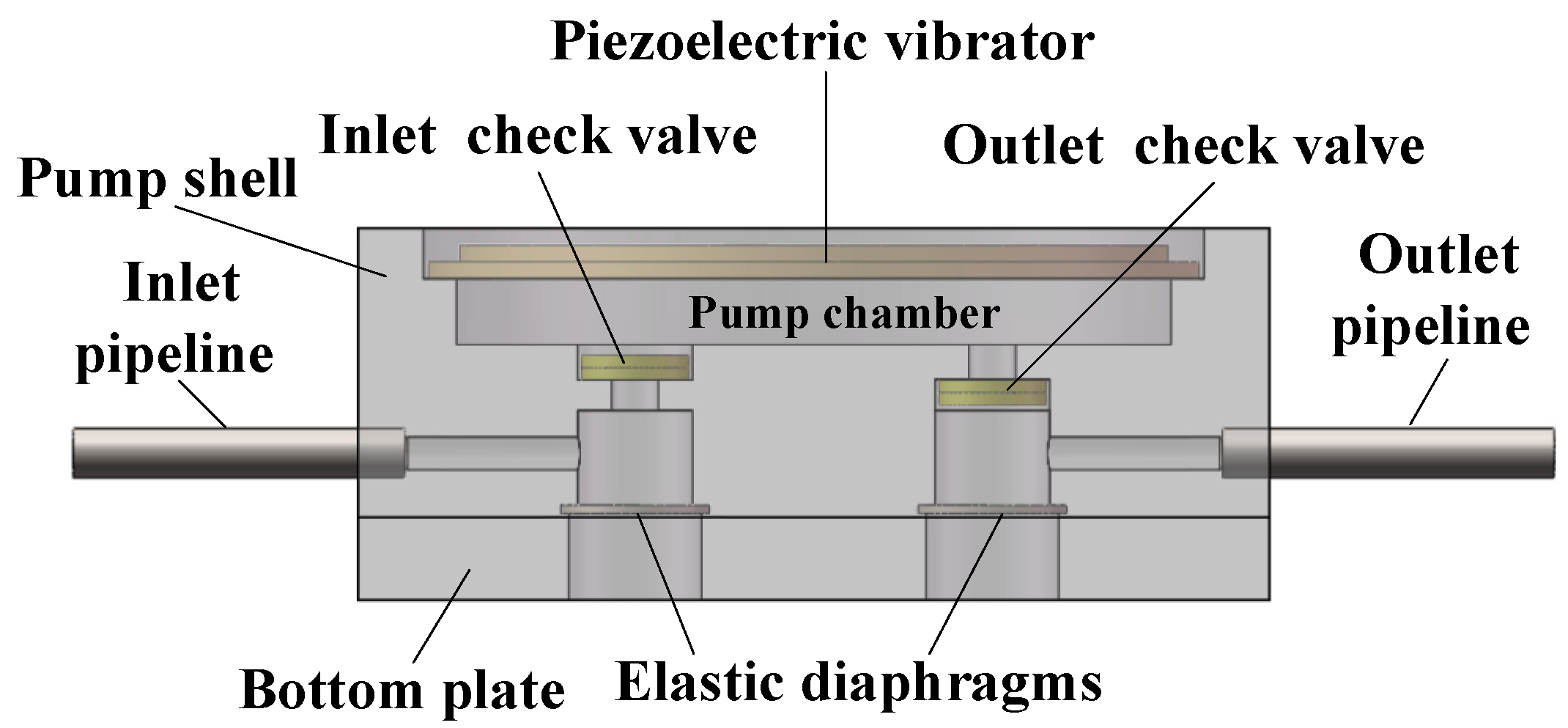

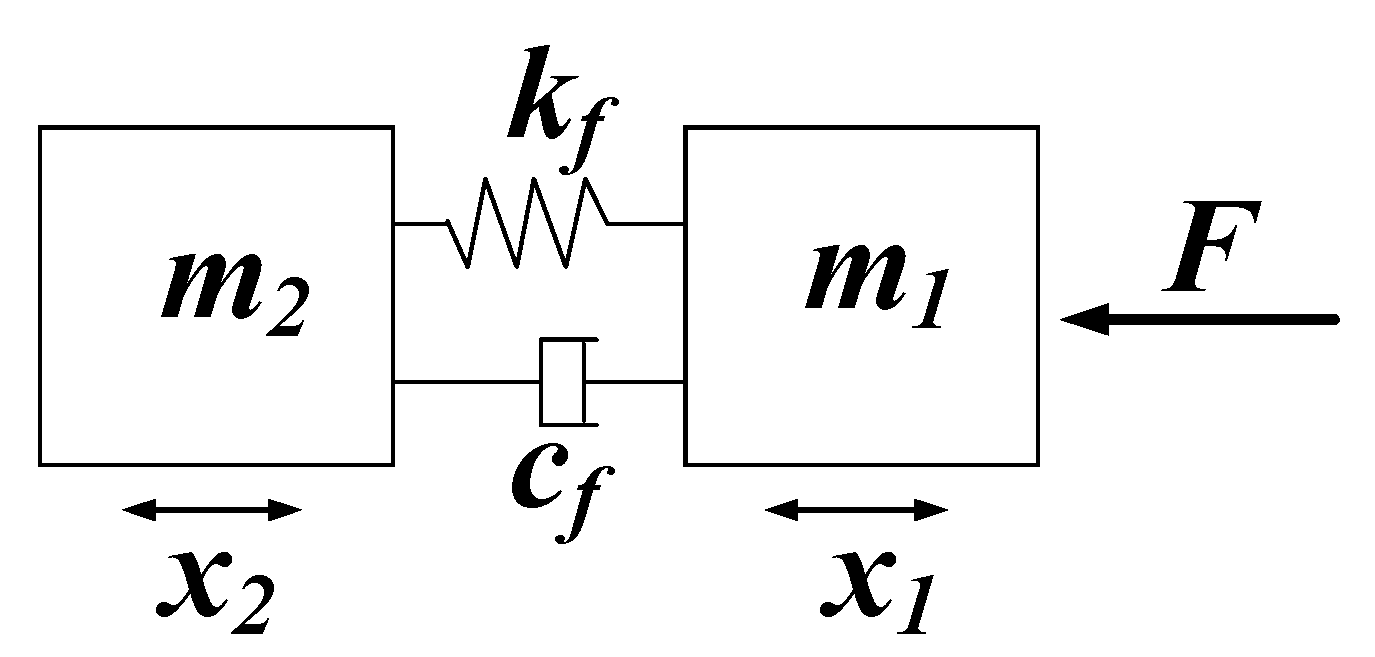

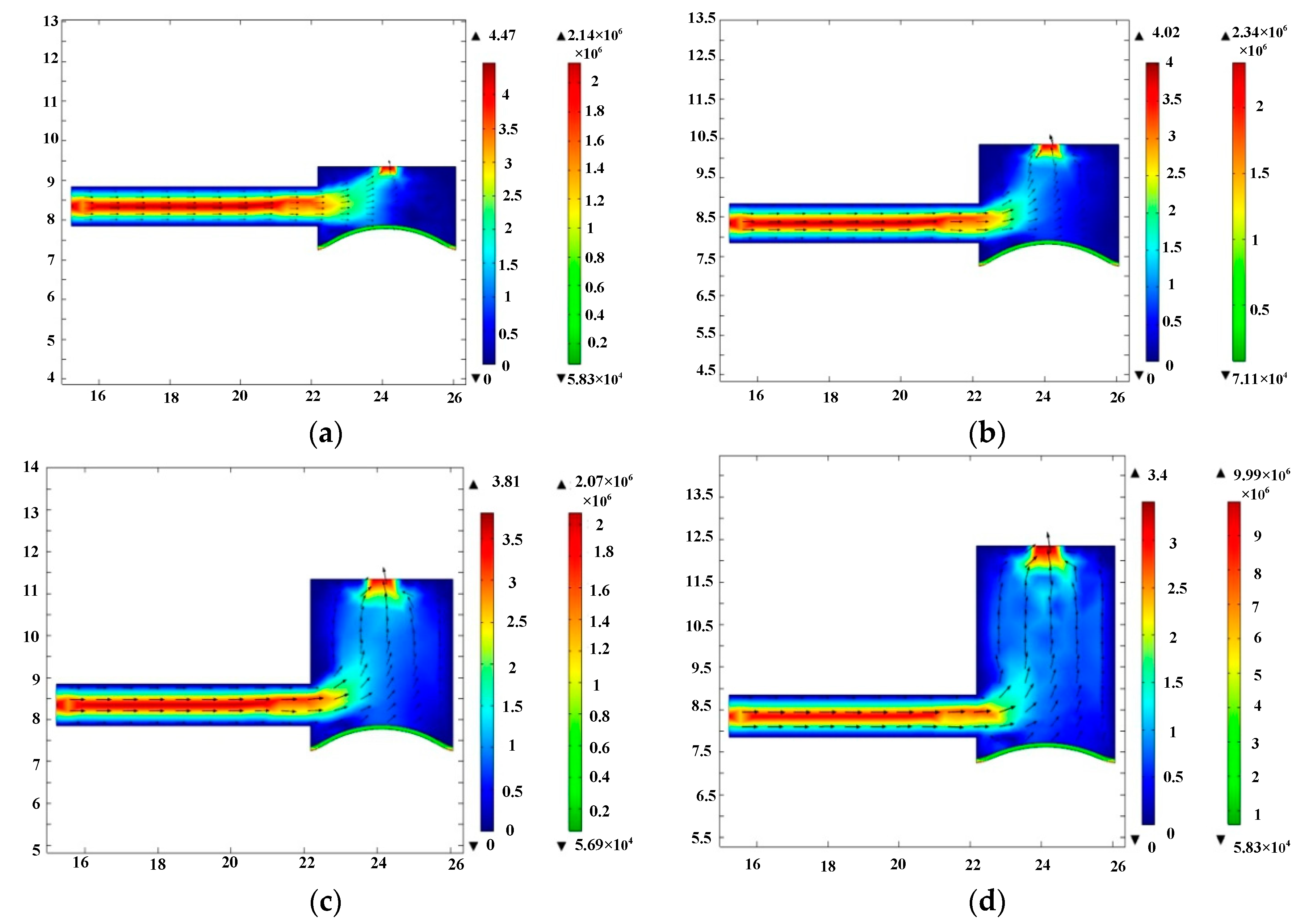
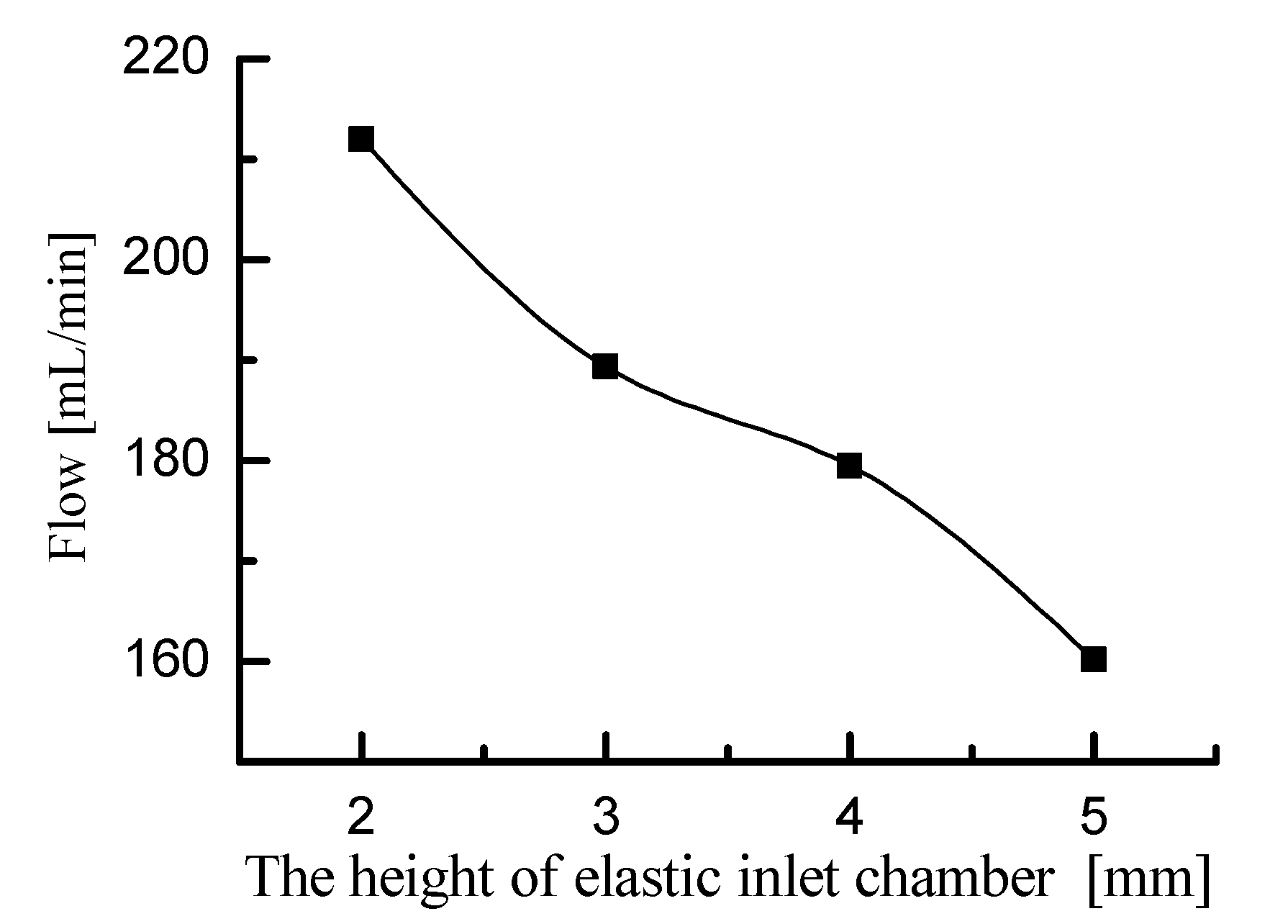

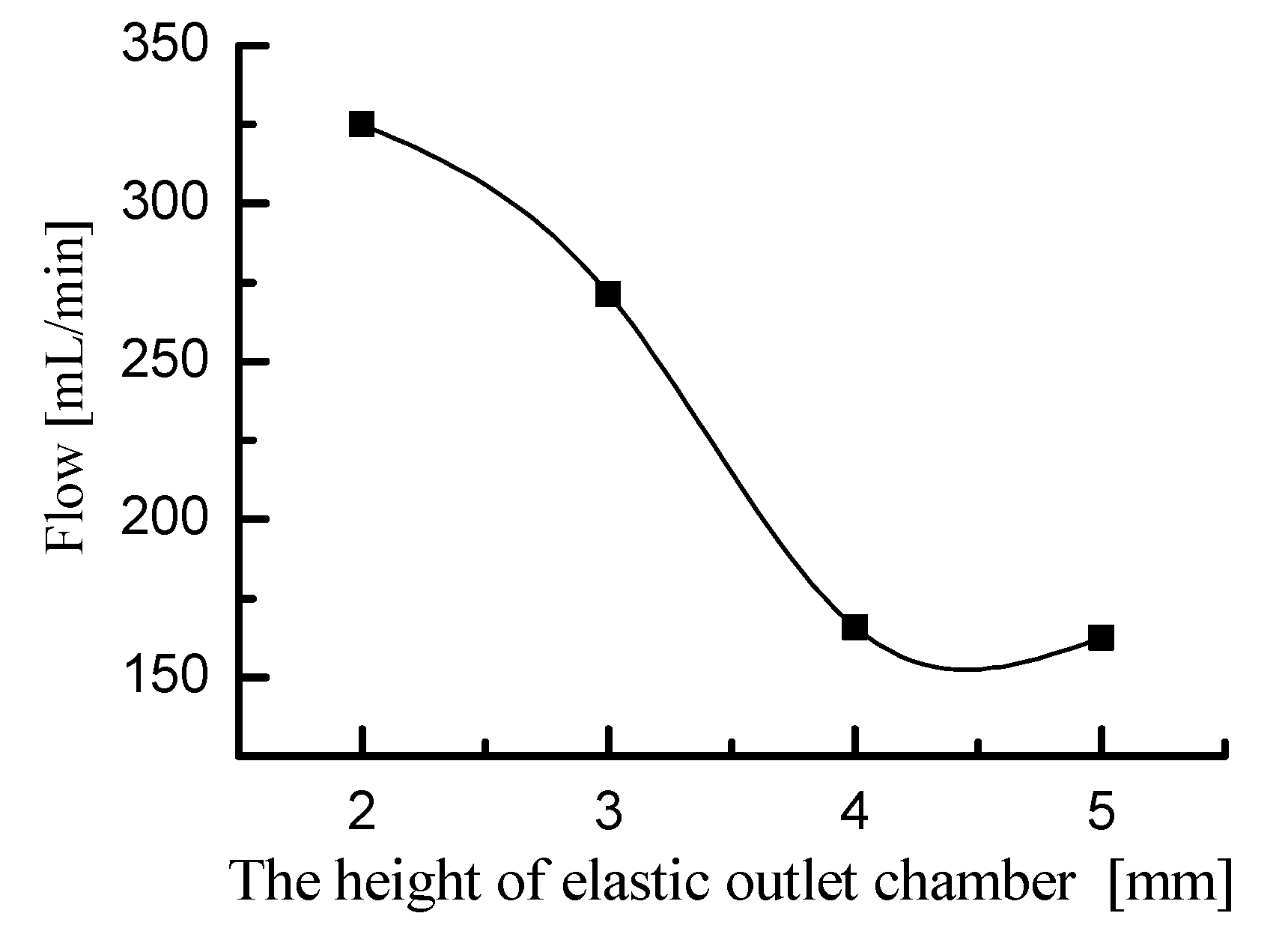


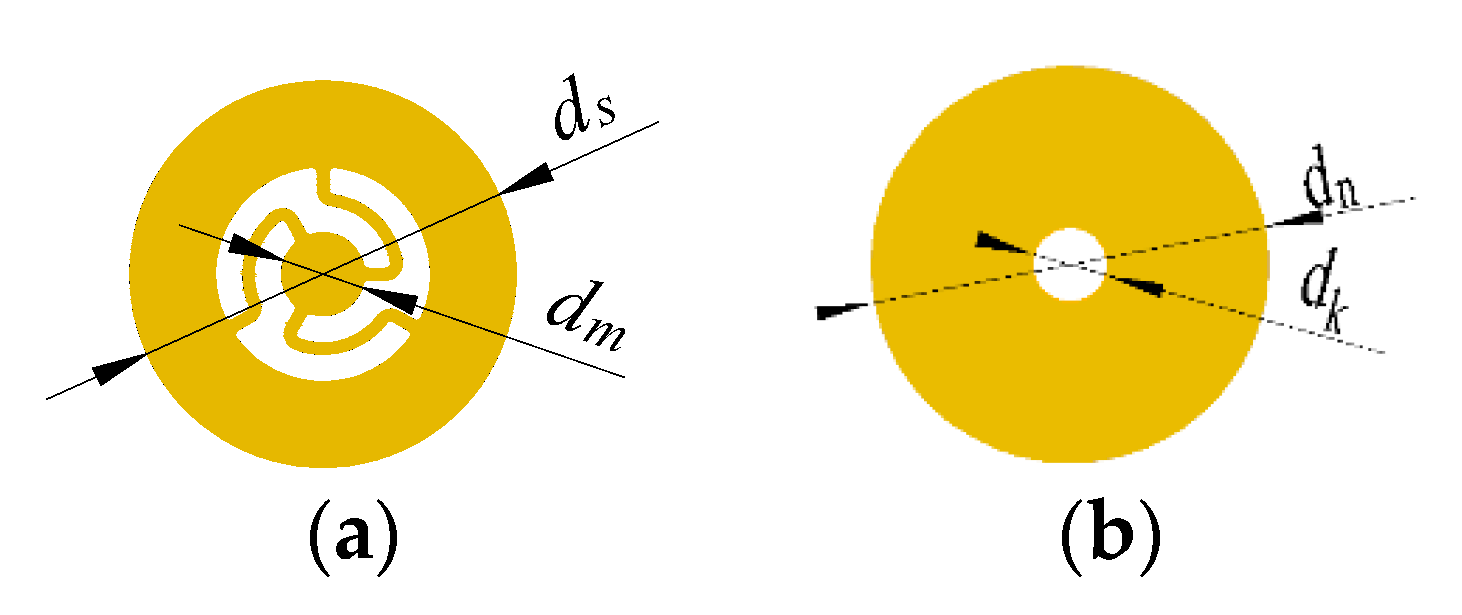
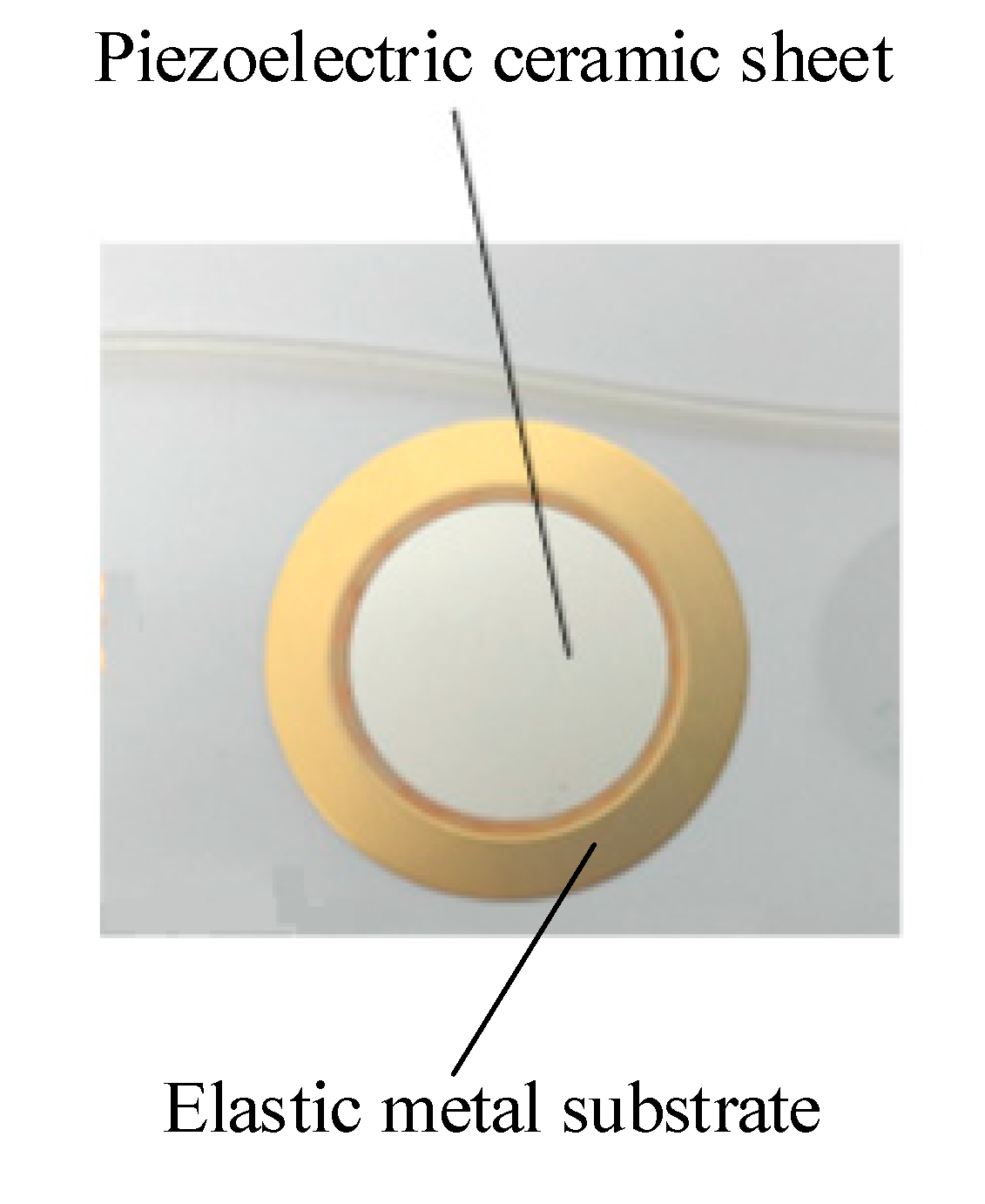
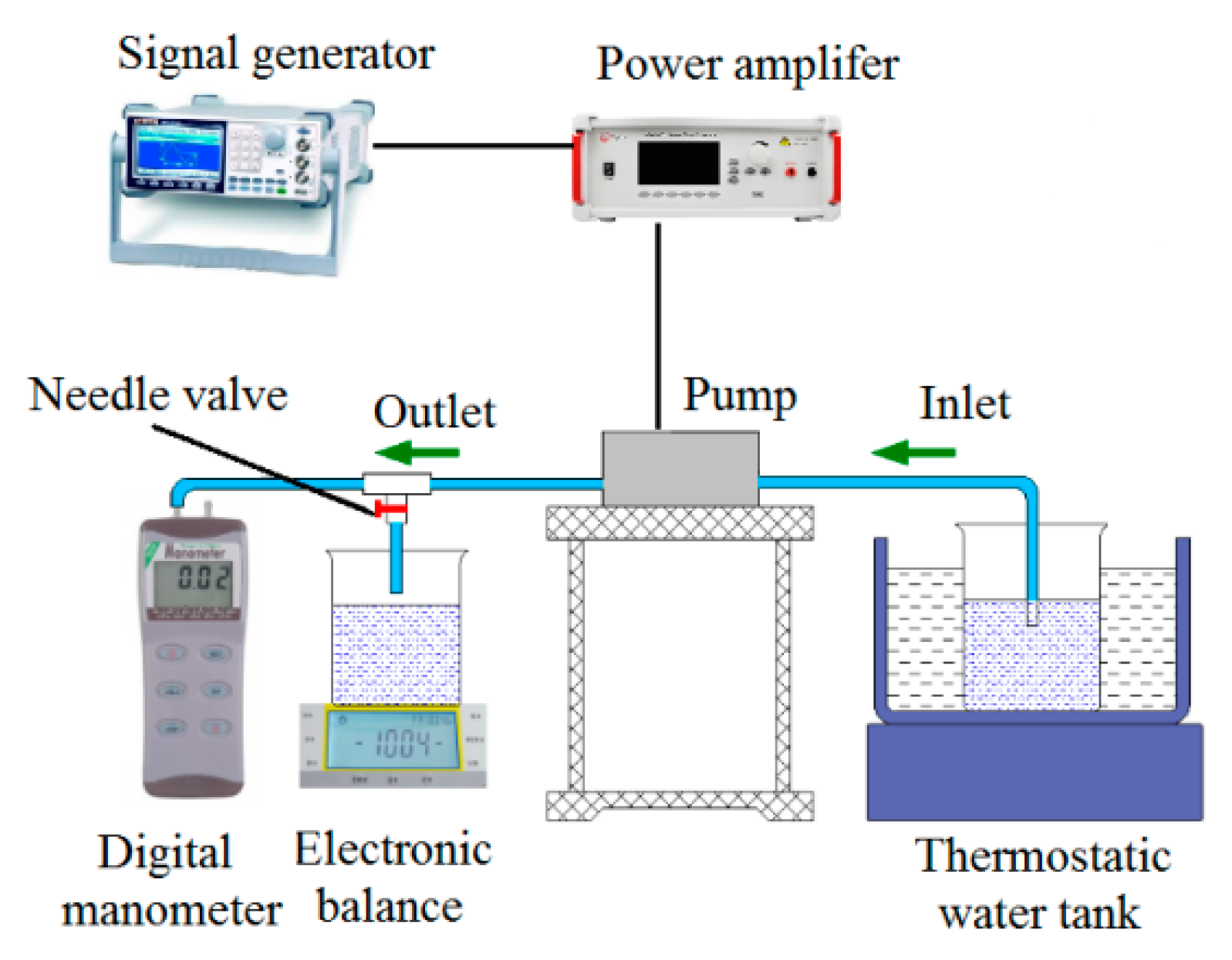
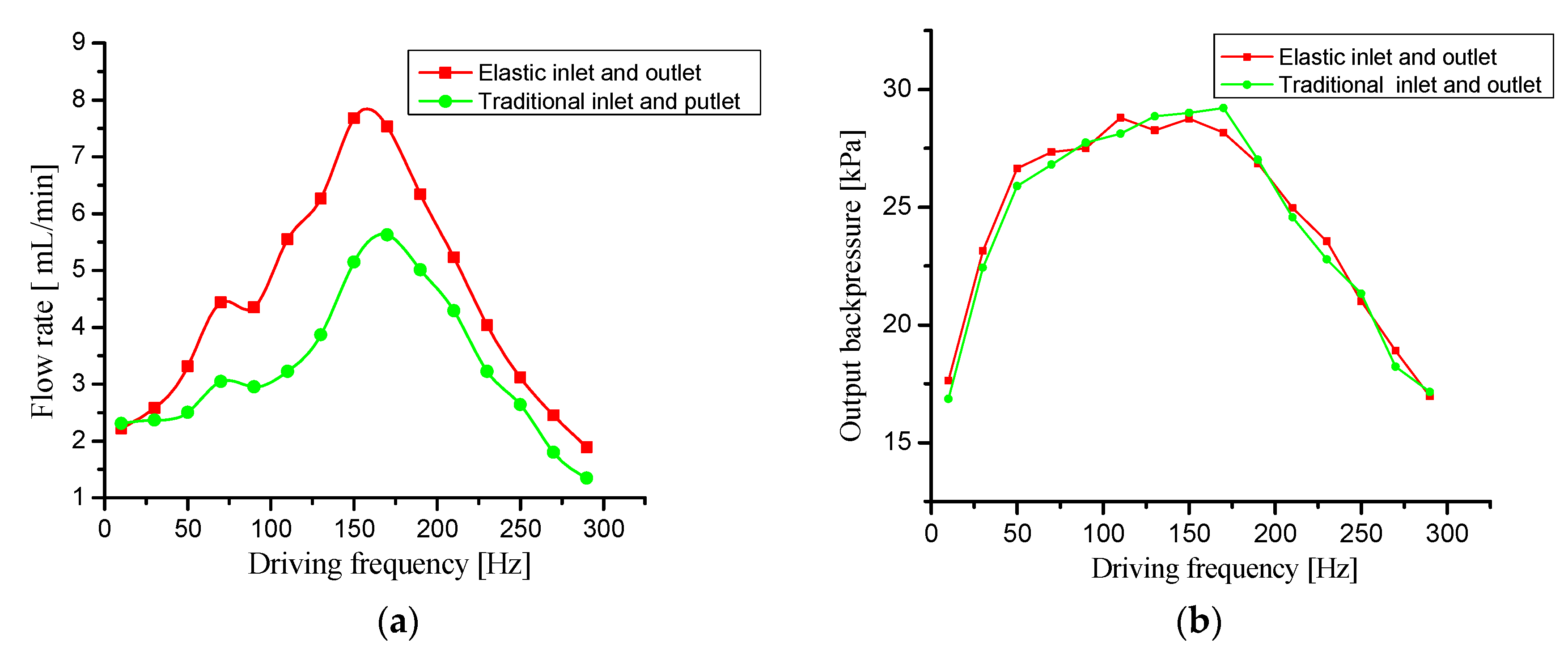
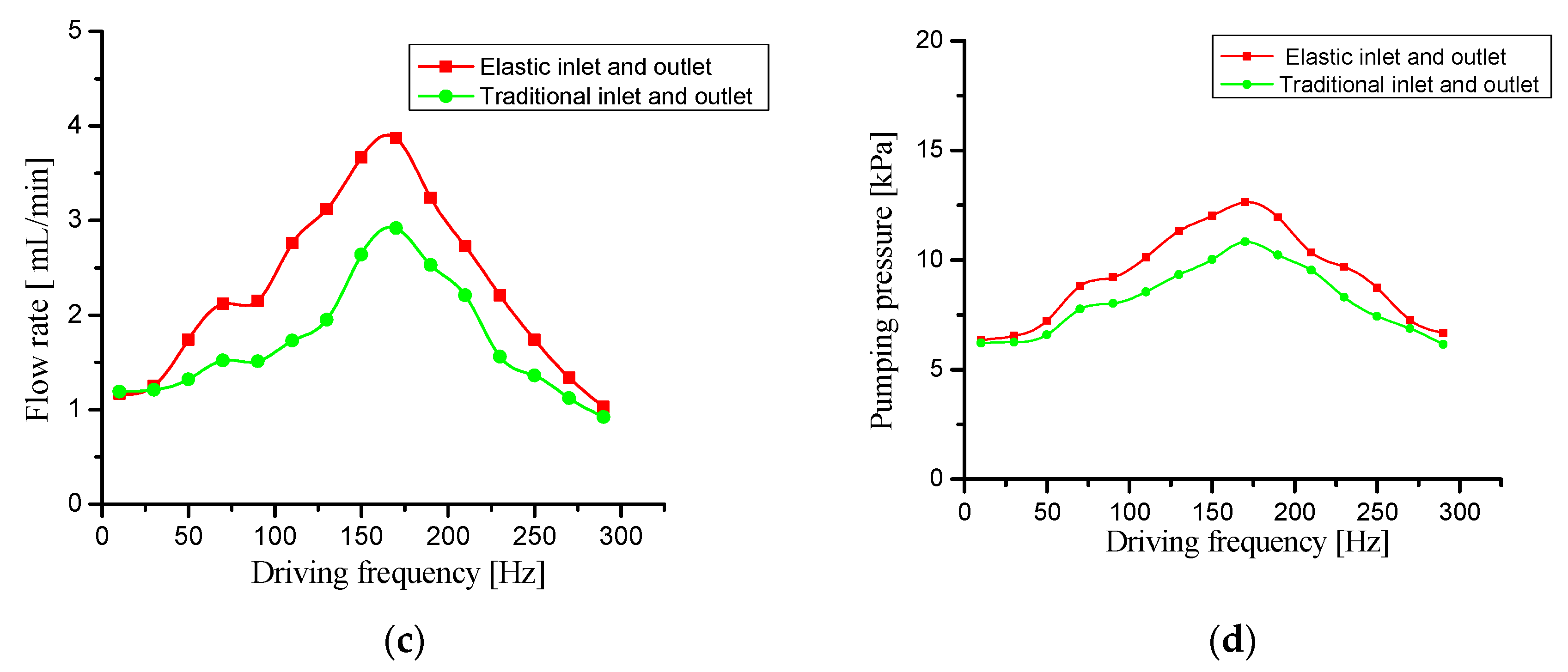

| Structural Parameters | Values |
|---|---|
| Diameter and thickness of piezoelectric vibrator | Φ20 × 0.4 (mm) |
| Diameter and thickness of the metal substrate | Φ20 × 0.2 mm |
| Diameter and thickness of the piezoelectric ceramic sheet | Φ16 × 0.2 mm |
| Outer diameter of wheeled valve piece ds | 5 mm |
| Outer diameter of the moving disc on the wheeled valve piece dm | 1.4 mm |
| Thickness of wheeled valve piece | 0.03 mm |
| Outer diameter of valve plate dn | 5 mm |
| Diameter of center hole of valve plate dk | 1.2 mm |
| Thickness of valve plate | 0.05 mm |
| Height of the pump chamber | 0.15 mm |
| Diameter of inlet and outlet pipeline | 1.5 mm |
| Thicknesses of elastic diaphragm | 0.2 mm |
| Height of elastic cavity | 2, 3, 4, 5 mm |
| Diameter of elastic cavity | 3 mm |
© 2020 by the authors. Licensee MDPI, Basel, Switzerland. This article is an open access article distributed under the terms and conditions of the Creative Commons Attribution (CC BY) license (http://creativecommons.org/licenses/by/4.0/).
Share and Cite
Zhao, X.; Zhao, D.; Wang, J.; Li, T. Research on Inlet and Outlet Structure Optimization to Improve the Performance of Piezoelectric Pump. Micromachines 2020, 11, 735. https://doi.org/10.3390/mi11080735
Zhao X, Zhao D, Wang J, Li T. Research on Inlet and Outlet Structure Optimization to Improve the Performance of Piezoelectric Pump. Micromachines. 2020; 11(8):735. https://doi.org/10.3390/mi11080735
Chicago/Turabian StyleZhao, Xiaolong, Dingxuan Zhao, Jiantao Wang, and Tao Li. 2020. "Research on Inlet and Outlet Structure Optimization to Improve the Performance of Piezoelectric Pump" Micromachines 11, no. 8: 735. https://doi.org/10.3390/mi11080735
APA StyleZhao, X., Zhao, D., Wang, J., & Li, T. (2020). Research on Inlet and Outlet Structure Optimization to Improve the Performance of Piezoelectric Pump. Micromachines, 11(8), 735. https://doi.org/10.3390/mi11080735






